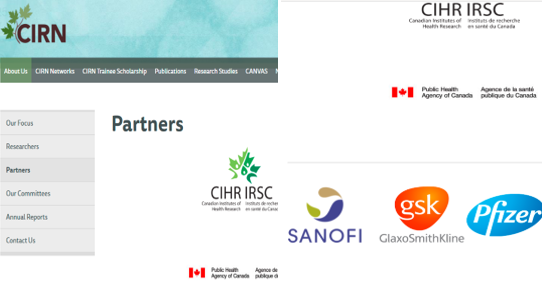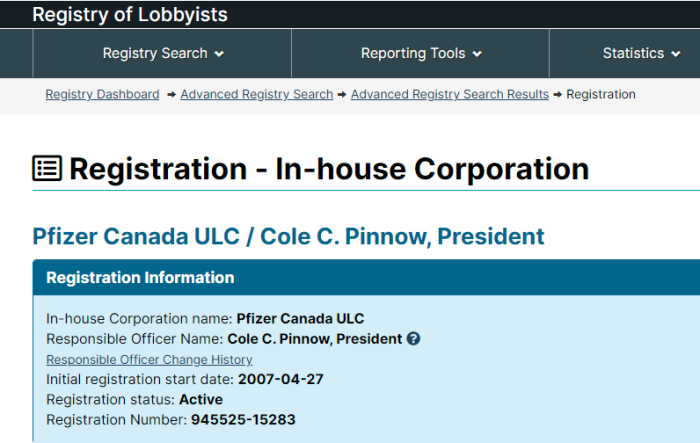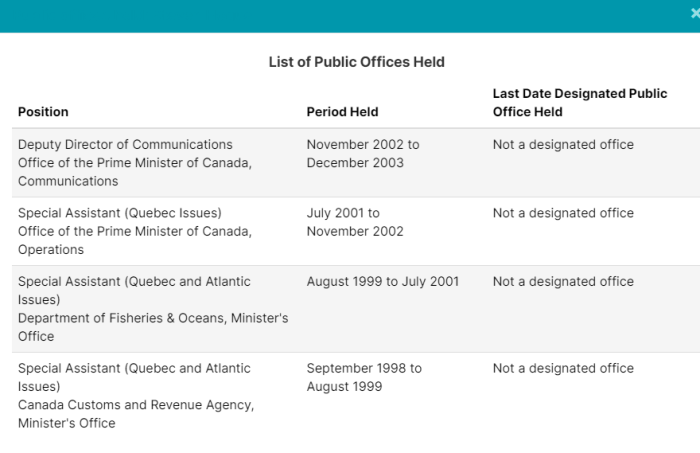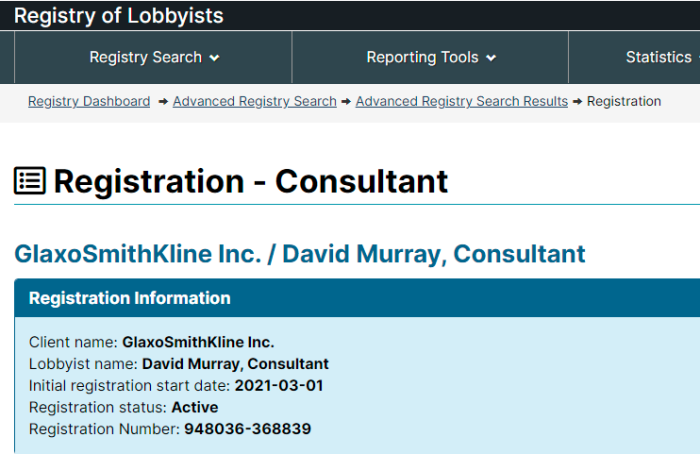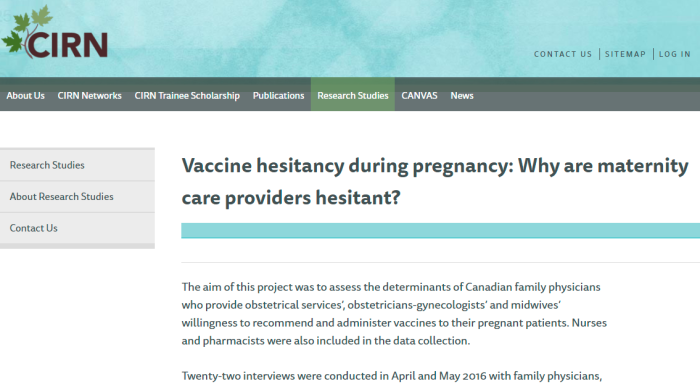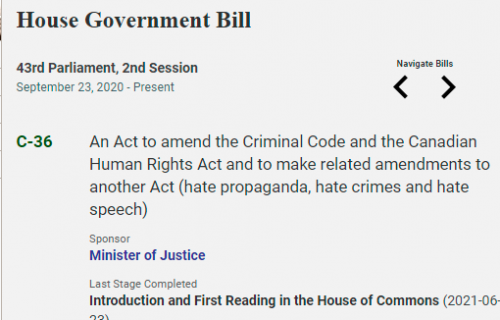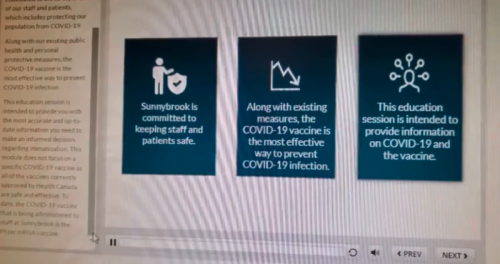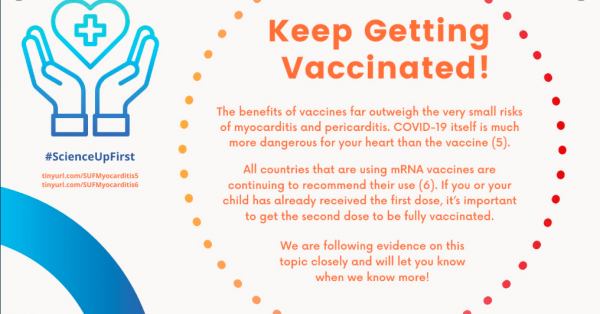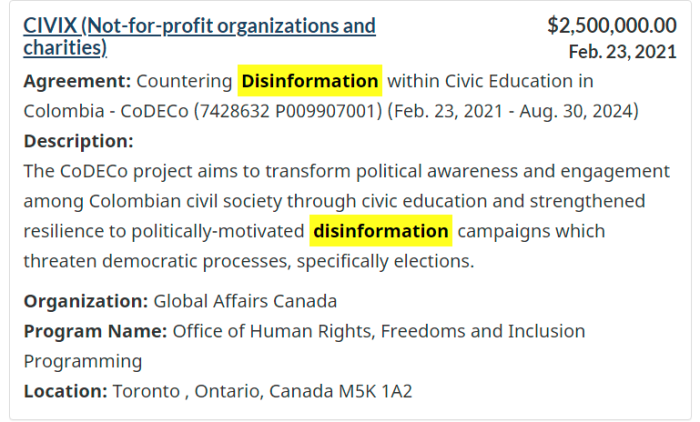

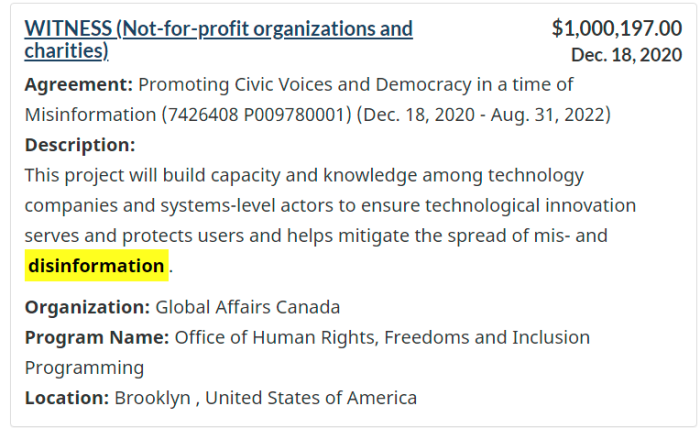
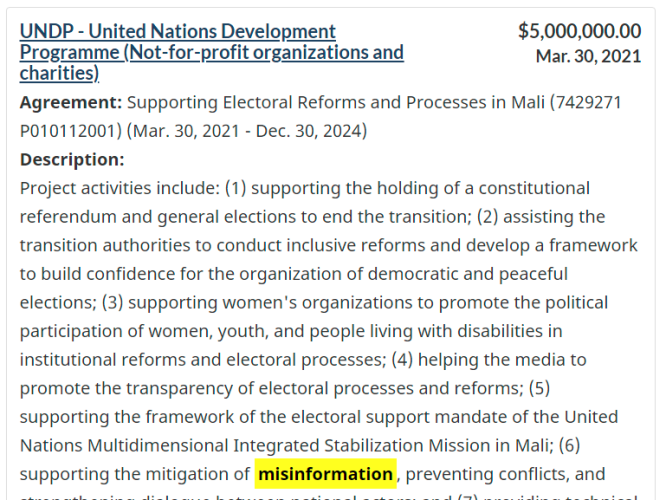
In addition to funding efforts to combat “misinformation” locally, Canadian taxpayers are apparently on the hook for efforts in the U.S., Colombia and Mali as well. Wonderful use of deficit spending.
RECENT GRANTS TO COMBAT “MISINFORMATION”:
| NAME | DATE | AMOUNT |
|---|---|---|
| CIVIX | Feb. 23, 2021 | $2,500,000 |
| Dubois, Elizabeth | Mar. 22, 2021 | $19,145 |
| Elnakouri, Abdelrahman | Jan. 1, 2021 | $10,000 |
| Farokhi, Zeinab | Jan. 1, 2021 | $10,000 |
| Gagnon, Marc-Andre | Mar. 15, 2021 | $20,000 |
| Gauthier, Evelyne | Jan. 1, 2021 | $10,000 |
| Hassanein, Khaled S. | Mar. 15, 2021 | $20,000 |
| Hastings, Colin | Jan. 1, 2021 | $10,000 |
| Henderson, Monica J. | Jan. 1, 2021 | $10,000 |
| IFEX | Dec. 14, 2020 | $799,704 |
| Jagayat, Arvin S. | Jan. 1, 2021 | $10,000 |
| Levitin, Daniel J. | Jan. 1, 2021 | $395,909 |
| Merkley, Eric | Jan. 1, 2021 | $10,000 |
| Naffi, Nadia | Jan. 1, 2021 | $99,081 |
| Petrina, Stephen | Mar. 15, 2021 | $20,000 |
| Reed, Kathleen J. | Jan. 1, 2021 | $10,000 |
| Russell, Gillian M. | Jan. 1, 2021 | $10,000 |
| Search for Common Ground | Dec. 16, 2020 | $2,573,553 |
| Smythe, Suzanne K.M. | Jan. 1, 2021 | $210,711 |
| Stewart, Michelle | Jan. 1, 2021 | $339,783 |
| Tilleczek, Kate C. | Mar. 15, 2021 | $20,000 |
| United Nations Development Programme | Mar. 30, 2021 | $5,000,197 |
| WITNESS | Dec. 18, 2020 | $1,000,197 |
Good to know that Canadians are forced to finance counter intelligence operations in other countries.
Locally, one of the biggest recipients of “misinformation prevention” grants is CIVIX. Now, who exactly is that?

CIVIX is a charity registered with the Canada Revenue Agency. This means that about half of the donations are a subsidy from taxpayers.
CIVIX Board Members
- Francis LeBlanc – Chair, Former Executive Director, Canadian Association of Former Parliamentarians
- Chris Wilkins – Past Chair, CEO, Edge Interactive
- Robert Asselin, Senior Director, Public Policy, Blackberry
- Megan Beretta, Policy Analyst, Canadian Digital Service
- Rachel Curran, Public Policy Manager, Canada, Facebook
- Peter Donolo, Vice-Chairman, Hill+Knowlton Strategies Canada
- Dr. Elizabeth Dubois, Assistant Professor of Communication, University of Ottawa
- Kathleen Monk, Principal, Earnscliffe Strategies
Peter Donolo is a longtime political operative with the Liberal Party of Canada. Rachel Curran spent years with the Conservative Party of Canada. Interesting.
CIVIX is a non-partisan, national registered charity dedicated to building the skills and habits of active and engaged citizenship among young Canadians. Our vision is a strong and inclusive democracy where all young people are ready, willing and able to participate.
.
CIVIX was born through a merger between Operation Dialogue and Student Vote – two non-partisan organizations with a significant history of engaging Canadian youth.
.
Student Vote was founded by Taylor Gunn and Lindsay Mazzucco in 2002 to develop the capacity for informed and engaged citizenship among young Canadians. Student Vote parallel elections were organized for students under the voting age coinciding with official elections.
.
Operation Dialogue was established by the late Warren Goldring of AGF Management in 1999 to promote good citizenship through information and dialogue with the goal of enhancing each individual Canadian’s appreciation of our country. Its flagship program was the annual ‘Talk About Canada Quiz,’ which encouraged young Canadians to be more informed about their country.
.
Operation Dialogue and Student Vote aligned their strengths and assets and worked together to achieve a larger vision. Following a collaborative approach during 2011-2012, the organizations formally merged operations in 2013 and created CIVIX.
.
Since 2013, CIVIX has continued to run the Student Vote program and has developed exciting new programs to reach students between elections.
While previously covered here, CIVIX is run by political hacks, who have bipartisan connections in Ottawa. This “counter-misinformation” group is anything but organic.
It’s also interesting the ETFO, the Elementary Teachers Federation of Ontario, and OSSTF, the Ontario Secondary School Teachers’ Federation, are supporters. Do their members know about this?
One project that CIVIX runs is CTRL-F, and it’s funded by the Canadian Government. This is supposed to help people become more aware in checking out source material.
Admittedly, CTRL-F/CIVIX do produce some quality videos on the topic of verifying sources. However, they remain silent on the topic of media censorship by government and tech companies. Easy to be pro-journalism when one has their thumb on the scale.
| DATE | AMOUNT |
|---|---|
| Jun. 13, 2014 | $100,000 |
| Jul. 24, 2014 | $100,000 |
| Apr. 30, 2015 | $75,000 |
| Feb. 17, 2016 | $75,000 |
| Mar. 24, 2016 | $25,000 |
| Feb. 24, 2017 | $75,000 |
| Feb. 24, 2017 | $225,000 |
| Apr. 1, 2017 | $25,000 |
| Mar. 23, 2018 | $165,000 |
| Apr. 1, 2018 | $400,000 |
| Apr. 1, 2018 | $175,000 |
| Nov. 15, 2018 | $23,000 |
| Dec. 10, 2018 | $100,000 |
| Apr. 1, 2019 | $540,000 |
| Jan. 1, 2020 | $494,320 |
| Apr. 1, 2020 | $132,500 |
| Apr. 1, 2020 | $192,300 |
| Feb. 23, 2021 | $2,500,000 |
In case you think this group is harmless, just remember, tax money is used to finance this group. We pay to push political agendas here and abroad, and were never asked about this.
(1) https://search.open.canada.ca/en/gc/
(2) https://civix.ca/
(3) https://civix.ca/supporters/
(4) https://ctrl-f.ca/
(5) https://www.youtube.com/watch?time_continue=7&v=ti0vtwY9kbI&feature=emb_logo
(6) https://www.youtube.com/c/CTRLF/videos
(7) https://canucklaw.ca/media-subsidies-to-counter-online-misinformation-groups-led-by-political-operatives/
(8) https://canucklaw.ca/digital-citizen-contribution-program/
(9) https://canucklaw.ca/disinfowatch-ties-to-atlas-network-connected-to-lpc-political-operatives/
(10) https://canucklaw.ca/journalism-trust-initiative-trusted-news-initiative-project-origin-the-trust-project/
(11) https://canucklaw.ca/phac-supporting-science-up-first-online-counter-misinformation-group/
(12) https://canucklaw.ca/media-in-canada-obedient-to-govt-covid-narrative-largely-because-of-subsidies/
(13) https://canucklaw.ca/postmedia-subsidies-connections-may-explain-lack-of-interest-in-real-journalism/
(14) https://canucklaw.ca/nordstar-capital-torstar-corp-metroland-media-group-more-subsidies-pandemic-bucks/
(15) https://canucklaw.ca/aberdeen-publishing-sells-out-takes-those-pandemic-bucks-to-push-narrative/
(16) https://canucklaw.ca/many-other-periodicals-receiving-the-pandemic-bucks-in-order-to-push-the-narrative/
(17) https://canucklaw.ca/cv-37i-tri-city-news-pulls-article-where-bonnie-henry-admits-false-positives-could-overwhelm-system/




